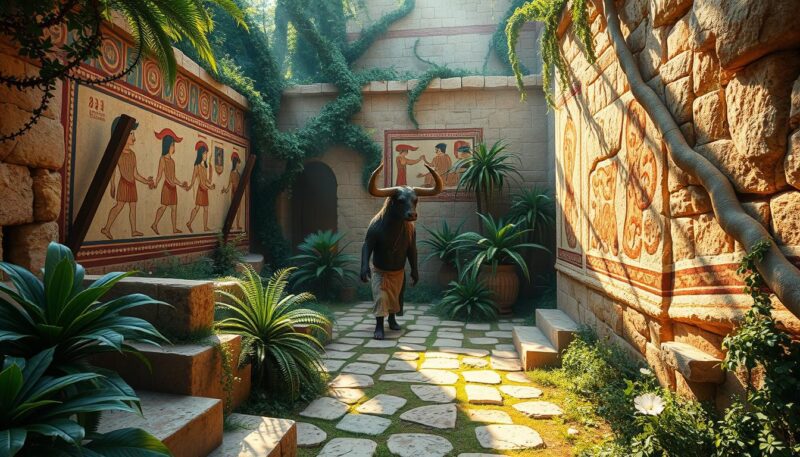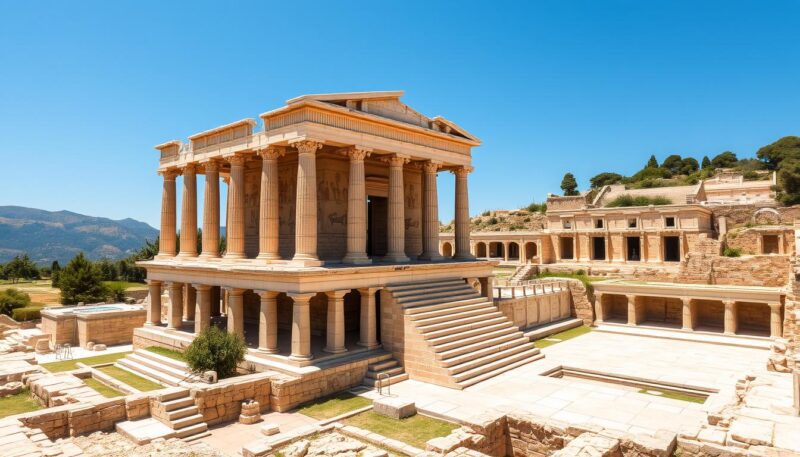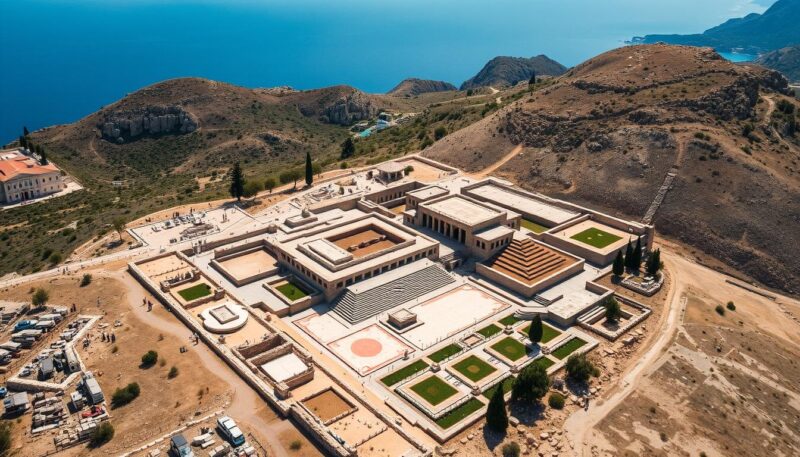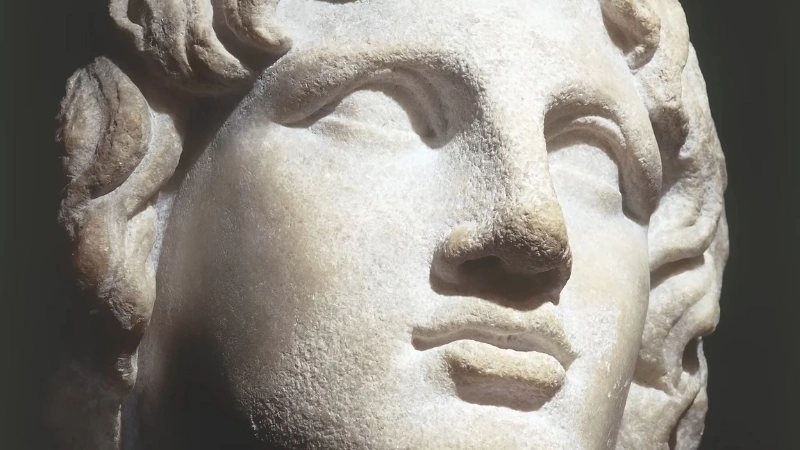
Share Post:
Embark on an incredible journey to the Palace of Knossos, located just outside Heraklion, Crete. This remarkable archaeological site is the centerpiece of the ancient Minoan civilization, widely acknowledged as the first advanced society in Europe. If you are a history buff or fascinated by ancient cultures, Knossos will not disappoint. The palace is rich with vibrant frescoes, the oldest throne room in Europe, and stories of the mythical labyrinth associated with King Minos. Situated approximately 5 kilometers south of modern-day Heraklion, Knossos offers you a profound glimpse into the intricate tapestry of ancient history, cultural heritage, and mythology.
The origins of Knossos date back as early as 6700 BC during the Neolithic period, making it one of the oldest inhabited locales on Crete. The palace itself thrived during the height of the Minoan civilization but faced destruction around 1700 BC, likely due to an earthquake. Despite being rebuilt, it seems to have been abandoned by 1380 BC for reasons still shrouded in mystery. The site began gaining recognition when it was discovered by Minos Kalokairinos in 1878, and profound excavations were led by Sir Arthur Evans starting in 1900. These efforts have offered invaluable insights into Minoan life, art, and architecture, further enriching the island of Crete’s appeal among Greece travel enthusiasts.
The Archaeological Museum of Heraklion, the second-largest museum in Greece, preserves an extensive collection of Minoan artifacts that reveal much about this ancient civilization’s daily life, rituals, and artistry. While in Heraklion, you can also explore other historical landmarks such as the Venetian Walls and the bustling Lions Square. With expert guides, Greek Island tours can enrich your visit by offering deeper insights into the myths and historical narratives that define Knossos and Crete overall.
To fully appreciate Knossos, understanding its complex history and recounted myths can greatly enhance your experience. Let’s delve deeper into what makes the Palace of Knossos an exceptional travel destination.
Table of Contents
ToggleKey Takeaways
- The Palace of Knossos is one of the oldest palatial sites in Europe, dating back to the Neolithic period.
- It was destroyed around 1700 BC and rebuilt, only to be abandoned by 1380 BC.
- Knossos houses the oldest throne room in Europe, dating to the 15th century BCE.
- The site was extensively excavated by Sir Arthur Evans starting in 1900.
- The Archaeological Museum of Heraklion holds significant artifacts from Knossos and the Minoan civilization.
- More than 700,000 tourists visit Knossos annually, making it Greece’s second most popular archaeological attraction.
The Rich History of Knossos Palace
Knossos Palace stands as a testament to ancient history, boasting a unique blend of architectural grandeur and cultural significance. This archaeological site traces its ancient origins back to the Neolithic era, offering visitors an unparalleled glimpse into the evolution of early human settlement and craftsmanship.
Neolithic Beginnings
Established around 7000 BC, the earliest habitation layers of Knossos reveal primitive yet sophisticated settlements. These Neolithic roots laid the foundation for what would become a centerpiece in the history of the Minoan civilization. By the 19th century BC, the site witnessed substantial growth, evolving into a robust community with intricate pottery, early forms of writing, and complex social structures.
Minoan Civilization and Its Achievements
The construction of the first palace at Knossos around 1900 BC marked the dawn of an impressive era in the Minoan civilization. This period saw the rise of the Minoans’ extraordinary achievements in trade, art, and governance. The palace complex itself, spanning approximately 150,000 square feet, was replete with advanced features such as a comprehensive drainage system and elaborate frescoes. The resilience of the Minoans was evident as they rebuilt the palace following a catastrophic earthquake around 1720 BC, enhancing it with extensive colonnades. By dominating the Aegean from 1600 to 1400 BC, Knossos emerged as the epicenter of cultural and political influence in the region.
The Role of the Mycenaeans
The decline of the Minoan civilization ushered in the era of Mycenaean control around 1450 BC. During this time, significant shifts in cultural and linguistic paradigms occurred, with Greek becoming the administrative language. The “Last Palace” of Knossos, although eventually destroyed by fire around 1350 BC, showcased the Mycenaean’s influence through material culture and fortified structures. Despite subsequent destruction, Knossos continued to hold historical significance, later reviving during the Hellenistic and Roman periods.
Guided tours of Knossos Palace today offer a fascinating journey through its layers of history, from the ancient walls that silently narrate centuries of human endeavor to the intricate art that still captivates the eye. As you explore this remarkable archaeological site, you’ll uncover the enduring legacy of a civilization that significantly shaped the tapestry of ancient history.
Exploring the Archaeological Site
A visit to Knossos Palace offers you an immersive experience into the heart of Minoan culture. Guided tours provide invaluable insights as you traverse this sprawling archaeological site, covering six acres of fascinating ancient ruins. Let’s delve deeper into this magnificent complex, examining its key areas and uncovering their historical significance.

The Throne Room
The Throne Room is an essential part of the Knossos Palace. Here, you can marvel at the ancient grandeur that once flourished. The room is known for its stone seat, considered one of Europe’s oldest thrones, surrounded by beautifully adorned walls that feature mythical frescoes. Guided tours often highlight this area, giving you a glimpse into the ceremonial aspects of Minoan culture.
The Central Court
The Central Court is the heart of the archaeological site, where most communal and ceremonial activities occurred. Pivotal to the palace’s function, the court integrates thousands-of-years-old paving stones, which you can walk upon just as the ancient Minoans did. Historical records even suggest that bull leaping events, central to Minoan religious beliefs, were staged here.
The Royal Apartments and Frescoes
Next, explore the Royal Apartments, a prime example of Minoan sophistication. Pay particular attention to the Hall of the Double Axes and the Queen’s Megaron, both adorned with frescoes that have remarkably preserved their vivid colors over millennia. The dolphin frescoes in the Queen’s Megaron are a highlight of guided tours, showcasing Minoan artistry at its best.
East Wing and Practical Areas
The East Wing demonstrates the practical genius of the Minoans. This section includes storerooms and workshops essential for daily palace operations. Additionally, the advanced drainage systems discovered here underscore the innovative engineering capabilities that made Knossos Palace a leading structure in ancient Crete attractions.
| Area | Features | Significance |
|---|---|---|
| The Throne Room | Stone throne, frescoes | Ceremonial and administrative center |
| The Central Court | Paving stones, bull-leaping activities | Community and ceremonial gatherings |
| Royal Apartments | Hall of the Double Axes, dolphin frescoes | Demonstration of Minoan art and luxury |
| East Wing | Storerooms, workshops, drainage systems | Operational and practical infrastructure |
Visiting these areas within the archaeological site offers a well-rounded perspective on the complexity and ingenuity of ancient Minoan society. As you explore, you’ll uncover layers of history that describe life in this remarkable part of Crete attractions, making your journey through Knossos Palace unforgettable.
Interesting Facts About Knossos
When delving into the interesting facts about Knossos, you uncover layers of history that illuminate the brilliance of Minoan achievements. The Palace of Knossos near Heraklion stands as the most significant archaeological site from the Bronze Age, covering over 17,000 square meters. This substantial size underscores its historical importance and the enduring legacy of Minoan civilization.
Excavations at Knossos began in 1900, led by British archaeologist Sir Arthur Evans, unveiling a treasure trove of Knossos mythology and artifacts. Among the fascinating discoveries was the palace and its complex plumbing systems, which were advanced for their time. These innovations reflect the Minoans’ engineering prowess, a testament to their lasting cultural heritage.
The palace itself is renowned for its restored vibrant frescoes, giving us glimpses into the artistic achievements of the Minoan people. These frescoes depict various scenes, ranging from religious ceremonies to everyday life, showcasing the Minoan’s rich cultural tapestry. Notably, the Throne Room at Knossos is believed to be the oldest of its kind in Europe, offering a direct connection to Europe’s ancient rulers.
A visit to Knossos also brings to life the mysterious tales of the Minotaur and the labyrinth – a core element of Knossos mythology. This legend, interwoven with the fabric of Knossos’ history, continues to captivate the imagination of modern visitors. The strategic layout of the palace complex hints at the mythical labyrinth, further solidifying its place in mythological lore.
The discovery of the Phaistos Disc at the nearby Heraklion Archaeological Museum adds another layer of intrigue. This enigmatic artifact, adorned with mysterious symbols, remains one of the most puzzling relics of the Minoan era. Despite extensive research, its exact purpose and meaning elude scholars, inviting endless speculation and interest.
While Sir Arthur Evans’s restoration work on the Knossos Palace has faced some criticism, it undoubtedly provides a visual representation of the grandeur of the Minoan world. Although his use of concrete in the reconstruction has sparked debate, evoking mixed reactions from historians and archaeologists, it is these intricate facts and artifacts that weave a tangible connection to Knossos’s storied past.
Whether you’re a history enthusiast or a curious traveler, the multitude of interesting facts about Knossos makes it an essential stop on any traveler’s guide to Greece. Each corner of the site offers a new discovery, enriching your understanding of this ancient civilization and its remarkable achievements.
Tips for Visiting Knossos
When planning your visit to Knossos Palace on your Greece travel itinerary, a few strategic tips can make your experience more enjoyable and efficient. Given its proximity to Heraklion, it’s easily accessible and offers additional attractions nearby, such as the Archaeological Museum of Heraklion, which houses fascinating artifacts from the Minoan civilization.

One of the primary tips for visiting Knossos involves booking your tickets in advance, ideally online. This not only helps you avoid long queues but also often provides cost-saving discounts. Additionally, considering the site’s vast open-air terrain, wearing comfortable footwear is crucial to fully enjoy your exploration without discomfort.
To make the most of your visit, it’s advisable to start your exploration early in the morning or late in the afternoon. This allows you to evade the intense midday heat and the peak tourist crowds. Remember to bring essentials like water, sunscreen, and a hat to protect yourself from the strong Cretan sun. Navigating Knossos can be more enjoyable with a durable map on hand, as GPS services might be unreliable in the area.
Adding a guided tour to your traveler’s guide can significantly enrich your understanding of Knossos Palace. Expert guides provide deeper insights into the ancient history and intricate details of the palace, making your visit more informative and memorable.
Finally, complement your tour with a taste of local cuisine. Visiting nearby mountain town tavernas and sampling Cretan specialties like dakos, kalitsounia, and souvlaki can enhance your cultural experience significantly. Exploring the culinary delights of the region adds a delightful layer to your overall Greece travel adventures.
| Category | Recommendation |
|---|---|
| Booking | Purchase tickets online in advance |
| Best Time | Early morning or late afternoon |
| Essentials | Water, sunscreen, hat, comfortable shoes |
| Guided Tours | Hire an expert guide for in-depth information |
| Local Cuisine | Try local dishes like dakos, kalitsounia, souvlaki |
Conclusion
Undoubtedly, Knossos Palace stands as a beacon of ancient history and a testament to cultural heritage. From its Neolithic origins to its apogee under the Minoan civilization, Knossos is a remarkable landmark whose influence permeates through Greece’s vibrant tapestry. The palace’s sophisticated design, advanced plumbing systems, and stunning frescoes reveal a complex and thriving society that flourished over millennia.
Visiting Knossos offers you an unrivaled opportunity to step back in time and witness firsthand one of Europe’s oldest cities. The strategic positioning of Knossos along Crete’s northern coast underscores its importance in ancient maritime trade. As you wander through the intricate ruins, the legacy of the Minoans—evident in the Throne Room, the Central Court, and the Royal Apartments—comes vividly to life. The myths intertwined with the site, such as the tales of King Minos and the Minotaur, enhance its allure, making it a cornerstone of both history and mythology.
As a UNESCO World Heritage Site, Knossos continues to captivate visitors with its combination of historical significance and mythological intrigue. Whether you’re passionate about Greece travel, fascinated by ancient civilizations, or simply in search of a memorable landmark to explore, Knossos promises a rich and engaging experience. By immersing yourself in its storied past, you contribute to the preservation of its cultural legacy, ensuring that the brilliance of the Minoan civilization endures for future generations. Your journey through Knossos is more than just a visit; it’s a step into a world where history and legend converge, leaving an indelible mark on your travel memories.
Source Links
- https://thegenxtravels.com/2019/10/17/knossos-palace-in-crete-greece/
- https://www.contexttravel.com/blog/articles/crete-knossos-heraklion-archaeology
- https://travelhelix.com/2019/02/09/the-minoan-palace-of-knossos-controversial-past-reflections-on-the-present/
- https://www.historyhit.com/locations/knossos/
- https://www.britannica.com/place/Knossos
- https://en.wikipedia.org/wiki/Knossos
- https://kids.kiddle.co/Knossos
- https://www.world-archaeology.com/travel/knossos-journey-to-the-centre-of-the-labyrinth/
- https://www.getreadyforadventure.com/knossos-in-crete-a-mythical-city-with-history-and-interesting-facts/
- https://kidskonnect.com/geography/knossos/
- https://knossos-palace.gr/2023/11/01/10-tips-and-tricks-for-an-unforgettable-knossos-palace-experience-from-alexandra/
- https://mini-adventures.com/knossos-palace-crete-guide/
- https://cliomusetours.com/visit-knossos-facts-and-tips-to-know-ahead/
- https://facts.net/world/landmarks/14-astounding-facts-about-knossos/
- https://greeking.me/blog/crete/knossos-palace
- https://knossos-palace.gr/knossos-history/
Related Posts:
- Is Bacalar Worth Visiting in 2024? A Comprehensive…
- When to Get Waxed Before Wedding? A Bridal Grooming Guide
- How to Spot Misinformation in Travel Blogs - What…
- How to Check Your Pet’s Health Before Traveling - A…
- One Day in Mexico City - A 2024 Guide for First-Time…
- Top Casinos to Visit in Las Vegas ─ A Guide for…






